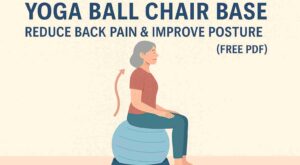Tadasana Mountain Pose: Tadasana, also known as the Mountain Pose, is one of the most fundamental and essential yoga poses that serves as the starting point for various other postures. This seemingly simple pose is often underestimated, but its significance in yoga cannot be overstated. The word “Tadasana” is derived from two Sanskrit words: “Tada,” meaning mountain, and “Asana,” meaning pose. Therefore, Tadasana translates directly to Mountain Pose.
Table of Contents
Understanding Tadasana Mountain Pose
The Mountain Pose Tadasana is not just about standing upright; it is about cultivating a strong, grounded, and balanced foundation that mimics the stability and majesty of a mountain. It is a pose that embodies strength, stability, and stillness. When practiced correctly, Tadasana improves posture, enhances body awareness, and prepares the body for more advanced yoga postures.

How to Perform Tadasana Mountain Pose)
Performing Tadasana correctly requires attention to detail and mindfulness. Follow these steps to ensure proper alignment and execution:
- Starting Position: Stand tall with your feet together or hip-width apart. Distribute your weight evenly across both feet, grounding yourself firmly into the floor.
- Engage Your Legs: Tighten your thigh muscles and lift your kneecaps, while keeping a slight bend in the knees to avoid locking them. This action helps to activate your quadriceps and create stability in the lower body.
- Align the Pelvis: Tuck your tailbone slightly to lengthen the spine and prevent the lower back from arching. Imagine a straight line running from the crown of your head to your heels.
- Open the Chest: Lift your sternum and broaden your collarbones, creating space in the chest. Allow your shoulders to relax away from your ears.
- Arm Position: Let your arms hang naturally at your sides with your palms facing forward. Alternatively, you can bring your hands together in front of your heart in a prayer position (Anjali Mudra) for a more meditative approach.
- Gaze: Focus your gaze straight ahead, keeping your chin parallel to the floor. This helps to maintain a neutral head and neck position.
- Breathing: Take deep, even breaths, inhaling through your nose and exhaling through your mouth. Allow your breath to flow naturally, synchronizing it with your movements.
- Final Check: Ensure that your body is aligned from head to toe. Engage your core muscles to support your spine, and feel the strength and stability of the pose.

Benefits of Practicing (Tadasana Mountain Pose)
The Mountain Pose offers a wide range of physical and mental benefits, making it a valuable addition to any yoga practice. Some of the key benefits include:
- Improves Posture: By aligning the spine and promoting proper body mechanics, Tadasana helps to correct poor posture and reduce the risk of back pain and related issues.
- Enhances Balance and Stability: Tadasana strengthens the muscles of the legs, ankles, and feet, improving balance and coordination. This is especially beneficial for individuals who struggle with stability or are prone to falls.
- Increases Body Awareness: The mindful focus required in Tadasana helps to develop a heightened sense of body awareness. This awareness extends beyond the pose itself and can positively impact daily activities.
- Promotes Mindfulness and Relaxation: Practicing Tadasana encourages a sense of grounding and connection to the present moment. It can serve as a meditative pose that calms the mind and reduces stress.
- Prepares the Body for Other Poses: Tadasana is often used as a starting position for many other yoga poses. It helps to establish a strong foundation and prepares the body for more complex postures.

Common Mistakes to Avoid in Tadasana
While Tadasana may appear simple, there are common mistakes that practitioners should be mindful of to avoid misalignment and maximize the benefits of the pose:
- Locking the Knees: Hyperextending or locking the knees can put unnecessary strain on the joints and lead to discomfort. Keep a slight bend in the knees to maintain proper alignment.
- Arching the Lower Back: Allowing the lower back to arch excessively can disrupt the alignment of the spine. Focus on tucking the tailbone slightly to maintain a neutral spine.
- Tension in the Shoulders: Holding tension in the shoulders can lead to stiffness and discomfort. Relax the shoulders and allow them to move away from the ears.
- Uneven Weight Distribution: Failing to distribute weight evenly across both feet can cause instability and affect the overall balance of the pose. Ground both feet firmly into the floor.
- Incorrect Head Position: Tilting the head forward or backward can strain the neck muscles. Keep the chin parallel to the floor and the gaze straight ahead.

Is Mountain a Yoga Pose?
Yes, the Mountain Pose (Tadasana) is indeed a yoga pose and is considered the foundation of all standing yoga postures. While it may seem simple, it is a pose that requires attention to detail and a deep connection between the mind and body. Many yoga practitioners and teachers emphasize the importance of mastering Tadasana, as it sets the stage for more complex poses and sequences.

The Role of Tadasana in Yoga Practice
Tadasana is often referred to as the blueprint for other standing poses in yoga. It teaches practitioners how to establish a strong foundation, align the body, and cultivate a sense of stability. By mastering Tadasana, individuals can improve their performance in other poses such as Warrior I (Virabhadrasana I), Warrior II (Virabhadrasana II), and Tree Pose (Vrksasana). The principles of alignment and balance learned in Tadasana can be applied to various aspects of a yoga practice.
Incorporating Tadasana into Your Daily Routine
While Tadasana is traditionally practiced at the beginning of a yoga session, it can also be incorporated into your daily routine outside of yoga practice. Here are a few ways to integrate Mountain Pose into your everyday life:
- Morning Routine: Start your day with Tadasana to awaken your body and mind. This pose can help set a positive tone for the day ahead and promote mindfulness.
- Desk Break: If you spend long hours sitting at a desk, take a few moments to stand up and practice Tadasana. It can help alleviate tension in the back and shoulders and improve posture.
- Before Bed: Practicing Tadasana before bed can help calm the mind and prepare the body for a restful night’s sleep. Focus on deep breathing and grounding yourself in the present moment.
- Mindful Movement: Throughout the day, practice Tadasana whenever you find yourself standing still. This could be while waiting in line, cooking, or brushing your teeth. It’s an opportunity to engage your muscles, improve posture, and practice mindfulness.
Conclusion: The Power of (Tadasana Mountain Pose)
Tadasana, or Mountain Pose, is much more than a simple standing posture. It is a powerful tool for developing strength, balance, and mindfulness in both yoga practice and daily life. By understanding the nuances of this pose and incorporating it into your routine, you can experience its profound benefits and lay the foundation for a successful and sustainable yoga practice.












1 thought on “How to do Tadasana Mountain Pose”
Pingback: Which is better for osteoporosis yoga or pilates? (2024)